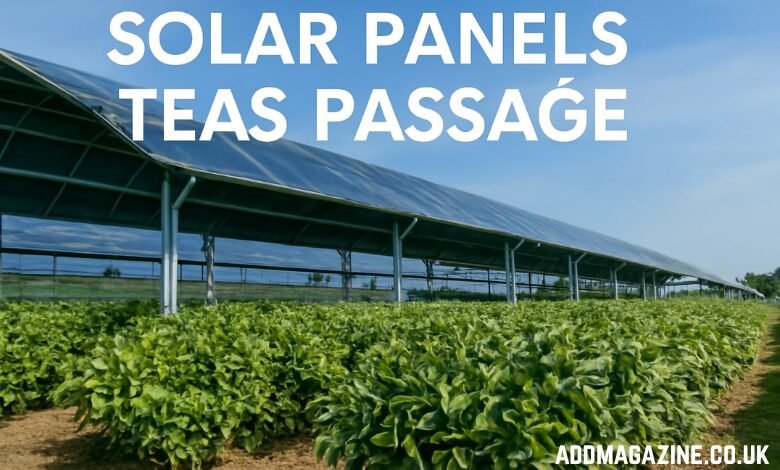“Solar Panels Teas Passage” is a term that combines the use of solar energy technology (solar panels) with tea farming. While the phrase itself may not be widely recognized or standard, it clearly refers to a sustainable approach in which solar panels are integrated into tea plantations, facilitating both clean energy generation and optimized crop growth. This method revolves around the concept of agrivoltaics, where solar panels are strategically placed above tea plants, creating a symbiotic relationship between energy production and agriculture.
The name “Solar Panels Teas Passage” emphasizes the idea of a passage, or pathway, toward a more sustainable and energy-efficient future for tea farming. It represents a practical solution that merges modern solar technology with traditional agricultural practices to address the challenges faced by tea farmers today.
Meaning of Solar Panels Teas Passage
The term “Solar Panels Teas Passage” essentially refers to the practice of integrating solar panels into tea farming landscapes to achieve multiple objectives: produce renewable energy, protect tea plants from extreme heat, and improve water retention for better crop growth. The “passage” part of the name suggests a new route or solution for tea farmers, providing them with a sustainable way forward in an era where climate change, unpredictable weather, and rising energy costs are major concerns.
Breaking Down the Words in Solar Panels Teas Passage
- Solar Panels: These are devices that convert sunlight into electricity using photovoltaic cells. Solar panels are widely used as a clean and renewable energy source, reducing dependence on fossil fuels and helping combat climate change.
- Teas: Refers to tea farming, specifically the cultivation of tea plants (Camellia sinensis) that produce the leaves used in making tea. Tea farming requires specific climatic conditions, such as moderate temperatures and consistent rainfall, making it vulnerable to changing weather patterns.
- Passage: In this context, “passage” suggests a new pathway or transition to a more sustainable and energy-efficient method of farming. It symbolizes the shift from traditional farming to an innovative and eco-friendly approach, facilitated by solar technology.
Why the Name?
The term “Solar Panels Teas Passage” was likely coined to illustrate the concept of integrating solar power with tea cultivation as a solution for the challenges of modern tea farming. By using solar panels, tea farmers can not only generate renewable energy but also improve their farming practices, making this method a “passage” or a new way forward for sustainable tea production.
This name is likely used to convey the innovative and transformative nature of agrivoltaics within the context of tea farming. The integration of solar technology into agriculture is seen as a progressive solution that helps preserve the environment while improving the livelihoods of farmers.
The Concept of Solar Panels Teas Passage
The core concept behind Solar Panels Teas Passage is to use solar panels to enhance the efficiency of tea farming. Solar panels are installed above tea plants or in between rows of crops, providing shade and cooling effects to the plants while also generating electricity. This setup helps balance the needs of the crops (adequate sunlight and temperature) with the demands for renewable energy production. The solar panels not only support sustainable farming practices but also contribute to the broader goal of reducing greenhouse gas emissions and increasing the adoption of clean energy in agriculture.
The use of solar panels in tea farming has the potential to mitigate some of the issues faced by tea farmers, such as excessive heat, water scarcity, and increasing energy costs. The combination of agricultural productivity and solar energy generation presents a win-win situation, benefiting both the environment and the farmer’s bottom line.
The Start and Date of Solar Panels Teas Passage
The concept of agrivoltaics is not new, but the specific application to tea farming has gained traction only in recent years. While agrivoltaic systems began being studied and applied in various crops, the integration of solar panels into tea plantations is a relatively recent development. The idea of using solar panels in farming, particularly tea farming, started gaining attention around the mid-2010s as climate change and energy sustainability became more pressing issues.
While solar panels had been used in farming for many years, their adoption specifically in tea plantations has accelerated in the past decade as the demand for sustainable farming practices and renewable energy solutions has risen. The transition from traditional methods to agrivoltaics in tea farming is ongoing, with successful pilot projects emerging in countries like India, China, and Kenya, where tea is a major agricultural product.
Agrivoltaics: The Core of Solar Panels Teas Passage
What is Agrivoltaics?
Agrivoltaics, sometimes called “agrisolar,” is the practice of integrating solar panels into agricultural settings to create a mutually beneficial environment for both farming and energy production. In this system, solar panels are either placed above crops or installed alongside them. The concept aims to optimize land use by enabling both food production and clean energy generation in the same area.
For tea farming, agrivoltaics provides a unique solution by balancing the sunlight that tea plants require with the need for protection from extreme heat. The panels also reduce water evaporation, improve humidity retention, and, in many cases, reduce the need for artificial irrigation.
Benefits of Agrivoltaics in Tea Farming
- Energy Independence: By integrating solar panels, tea farms can generate their own renewable energy, reducing dependence on external electricity sources. This is particularly beneficial in rural or remote areas where access to reliable electricity can be limited or expensive.
- Protection from Heat: Tea plants are sensitive to high temperatures, and excessive heat can negatively affect their growth and quality. Solar panels provide shade, protecting the plants from harsh sunlight and helping regulate temperature fluctuations.
- Improved Water Management: The shade provided by solar panels helps reduce evaporation rates, preserving valuable water resources. This is especially important in areas where water is scarce or unpredictable.
- Increased Crop Yield: With stable environmental conditions created by solar panels, tea plants can thrive, potentially leading to higher yields and better-quality leaves. This is particularly important for premium tea production, where quality is paramount.
- Sustainability: The use of solar energy in tea farming reduces the carbon footprint associated with energy production. By relying on renewable energy, farmers contribute to environmental conservation and the fight against climate change.
Comparison of Agrivoltaics with Other Farming Practices
When compared to traditional farming methods, agrivoltaics offers several distinct advantages:
- Traditional Farming: Often relies solely on natural sunlight and external energy sources, with limited consideration for energy efficiency or sustainability. It is vulnerable to the effects of climate change and may require significant water usage.
- Hydroponic Farming: This soil-less farming technique requires controlled environments and substantial energy inputs, often from non-renewable sources. While efficient, it does not offer the same energy production benefits as agrivoltaics.
- Vertical Farming: Like hydroponics, vertical farming often relies on artificial lighting and temperature control, which can be energy-intensive. Agrivoltaics, on the other hand, harnesses free solar energy while also benefiting the crops.
Agrivoltaics stands out by integrating energy production and crop cultivation in a way that directly benefits both the farmer and the environment, while other practices focus either on efficiency or sustainability independently.
Different Uses of Agrivoltaics in Tea Farming
Agrivoltaics can be implemented in several ways within a tea farm:
- Row Placement: Solar panels are placed above rows of tea plants, creating shade and protecting crops from excessive sunlight while allowing them to receive the right amount of light.
- Canopy Design: In some systems, solar panels are installed on elevated structures, creating a canopy that provides shade and shelter for tea plants.
- Integrated Solar and Irrigation Systems: Solar panels can be used to power irrigation systems, reducing reliance on grid electricity and ensuring a consistent water supply.
- Solar-Powered Processing: In addition to generating electricity for farming operations, solar energy can be used to power tea processing plants, drying machines, and storage facilities.
Challenges of Integrating Solar Panels into Tea Farms
While the benefits of agrivoltaics are clear, there are also challenges that need to be addressed for successful implementation. These challenges include:
- Initial Investment Costs
One of the main barriers to adopting agrivoltaics is the initial cost of installing solar panels. While the long-term savings on energy costs can offset the upfront investment, the cost of purchasing and installing solar panels can be prohibitive for some farmers, especially in developing countries. However, the growing availability of subsidies and incentives for renewable energy projects is helping to make solar technology more accessible to farmers. - Technical Expertise
Setting up an agrivoltaic system requires specialized knowledge in both solar energy and agriculture. Farmers need to understand how to balance the needs of their crops with the placement and orientation of solar panels. Additionally, maintenance of solar systems requires technical expertise, which may not be readily available in all regions. - Potential Impact on Crop Growth
While solar panels provide shade, there is a risk that the panels may block too much sunlight, especially in areas where tea plants require more direct sunlight to grow. The careful design and placement of solar panels are essential to ensure that the tea plants receive the right amount of light while still benefiting from the protection provided by the panels. - Regulatory and Policy Barriers
In some regions, regulations and policies may pose challenges to the integration of solar panels on agricultural land. There may be zoning laws, land use restrictions, or other legal barriers that need to be navigated before solar installations can take place. Governments can play a crucial role in creating favorable policies and incentives to support agrivoltaic initiatives.
The Future of Agrivoltaics in Tea Farming
As the world moves toward more sustainable and renewable energy sources, agrivoltaics is likely to become an increasingly important part of agricultural practices, including tea farming. The combination of renewable energy generation with crop cultivation offers a promising solution to many of the challenges faced by tea farmers, from rising energy costs to climate change.
With ongoing advancements in solar technology and growing support for sustainable farming practices, the future of agrivoltaics in tea farming looks bright. By adopting agrivoltaics, tea farmers can not only improve the efficiency of their operations but also contribute to a more sustainable and resilient agricultural system.
Conclusion
Solar Panels Teas Passage represents a transformative approach to sustainable tea farming, combining solar energy with crop cultivation in a way that benefits both the environment and farmers. By leveraging agrivoltaic systems, tea farmers can improve crop yields, reduce water usage, and generate renewable energy, all while contributing to global sustainability efforts. As the world continues to face the challenges of climate change and energy costs, agrivoltaics offers a promising solution for the future of tea farming and agriculture at large.



